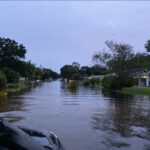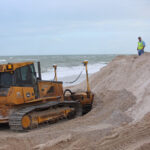INDIAN RIVER COUNTY – Indian River County is in the midst of its worst dry spell ever, according to National Weather Service Meteorologist Derrick Weitlich.
“Rainfall totals in Vero since October 1 when the dry season started are 11.98 inches, which is only 40 percent of normal,” Weitlich said Monday. “So it is a pretty significant dry period. In fact, it the driest dry season since 1942 when modern records start.”
Despite those dire numbers, the water supply is not in danger. Residents don’t have to worry whether water will flow when turning on taps on a hot, dry summer day because of the Floridan Aquifer and longstanding conservation and education efforts.
Based on a 30-year average, Vero Beach should have been soaked by 30 inches of cool, clear rainwater between the beginning of October and mid-June.
Rain totals for the calendar year are off almost as much. Since Jan. 1, the city has received only 9 inches of rain, about 45 per cent of the 19.9 inches it gets on average.
an extreme drought,” said Ed Garland, regional communications coordinator for the St. Johns River Water Management District. “Most of the county received less than an inch of rain for the entire month of May. Our rainy season should have begun about three weeks ago, but we all know rainfall has been scant. The headwaters of the St. Johns River, west of Vero, are extremely dry in most areas. I am seeing areas where you normally see bass boats that you can virtually walk across due to lack of rain.”
Founded by the State Legislature in 1972, St. Johns River Water Management District has primary responsibility for protecting and overseeing use of water resources in 15 eastern and central Florida counties from the Georgia border to Indian River County.
The district, which has 700 employees and annual revenues of more than $230 million, issues permits that regulate water withdrawals from the region’s two aquifers, buys and preserves wetlands and lakes, conducts research about the quality and quantity of ground and surface water, maps ground and surface water resources and conducts outreach and public education programs.
Thanks in part to district education and conservation programs, the drought hasn’t so far had a serious impact on Indian County residents.
Governor Rick Scott declared a statewide drought emergency June 14 and the lack of rainfall in East Central Florida has impacted the amount of water available in the Okeechobee, Osceola, Orange and St. Lucie counties, according to the National Weather Service, but water supplies in Vero Beach and the rest of Indian River County the county are in surprisingly good shape.
“Currently, there is no water emergency affecting utilities’ ability to provide water to customers,” said Garland. “This is largely due to the fact that we already enforce a year-round water conservation rule. There are also utility conservation programs and local government water conservation ordinances in place.”
The water conservation rule restricts lawn watering and other landscape irrigation to one day a week in the dry season and two days a week during the rainy season and is enforced by local police.
Garland said more than 900 people have been warned about unauthorized watering since July 2009.
First offenders receive a warning; second offenses draw a $50 fine, and third-time offenders can be hit with fines as high as $500.
“Our well field is holding up nicely,” said Roy Kain, manager of plant operations for the Vero Beach water utility. “We don’t see any problems at this time supplying water to our customers, and we don’t anticipate any problems going forward – though we could obviously use some rain.”
The city of Vero Beach draws water from 33 wells, 19 of which tap what is called the surficial aquifer, a layer of water-bearing limestone near the surface that is recharged by rainfall.
The other 14 wells extend into the Floridan aquifer, a deeper layer of limestone that underlies the entire state of Florida and is one of the most productive water sources in the world.
“Indian River County gets 100 percent of its water from the Floridan,” said Mike Hotchkiss, capital projects manager for the county water utility, which draws from 15 deep wells. “It is a confined aquifer, which means that it is protected and doesn’t get recharged from surface water.”
According to Hotchkiss, most water used here originates in Georgia and Alabama and flows downhill from those higher elevations to fill the natural reservoir beneath the county with an abundant supply that is not dependent on local rainfall.
“We are very fortunate to have that aquifer,” Hotchkiss says. “Some areas we regulate have been put under priority water cautionary, meaning they aren’t sure if the supplies are going to hold up in the long run because of development and overuse. But we don’t face anything like that here.”






